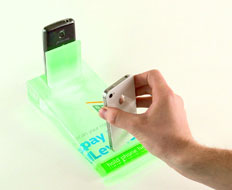The secret is out: there’s a problem with daily deals. Groupon, LivingSocial, (the late) BuyWithMe, and the rest forgot a big lesson from Sales Promotion 101 when they debuted the daily-deal model: discounts should, in the long run, generate a profit for the business. It’s the loyal customers, not the deal hunters, who help drive a business forward.
By failing to drive repeat business with huge one-time discounts, merchants are turning away from daily deals just as quickly as they signed on with them. But the good news is there’s a new deal model that’s here to solve all of your daily-deal problems. It’s called the inverted deal, and it flips everything the daily-deal model does wrong on its head.
The inverted deal works like this: Merchants seamlessly deliver a discount to consumers the first time they buy something. Think of it as credit waiting for the consumer to spend when they check out for the first time, no coupon necessary. Without any real effort on behalf of the consumer, they save. For the inverted deal to work, it needs to be baked into the payment. This is different than the daily deal, which requires the consumer to pre-purchase a deal that is redeemed when they buy something, often using paper in an awkward fashion.
If you don’t believe that such small changes in where and how a deal is delivered can drastically change your return on investment, prepare to be amazed. The power of the inverted deal lies in its ability to avoid two big problems that daily deals can’t manage to escape: price renormalization (the expectation that further purchases from that merchant should also be discounted) and benchmarking (the desire to spend the exact value of the deal).
While the daily-deal structure causes consumers to consider the value of their purchase to be equal to the deal amount—in other words, it renormalizes the value of their purchase—the inverted deal model avoids this notion. Instead, with inverted deals, consumers make their purchasing decisions before the discount is applied, which causes them to think of the value of their purchase in terms of its full price.
Daily deals also trigger the second problem, benchmarking, because the current model typically requires consumers to pre-purchase deals. This causes consumers to try to spend exactly the amount of the deal in order to avoid having to pay extra. Inverted deals, on the other hand, trigger the opposite effect of benchmarking because consumers think of the credit waiting for them at the merchant as bonus savings, so they’re more likely to spend more than the deal amount.
Sebastians Cafe, a breakfast and lunch quick-serve chain in the greater Boston area, has seen great results increasing customer loyalty and generating revenue with the inverted deal structure. Sebastians signed on with LevelUp, a high-tech loyalty-program-meets-mobile-payment method that uses this inverted deal structure.
LevelUp works like this: Consumers use the LevelUp mobile app to pay at merchants signed on with the program. The first time they visit each merchant, there’s credit (free money) waiting for them. They pay with LevelUp to use it. Paying with LevelUp is much like paying with the Starbucks Mobile Payment App. A QR Code gets scanned from a smartphone and voila, payment done. Push notification and e-mail receipt confirms the purchase. Then, as the customer comes back to that merchant and spends full price, they progress toward unlocking more credit, like a loyalty program.
Sebastians has experienced huge success by employing the inverted deal model. The proof is in the numbers:
• Customers who pay with LevelUp at Sebastians have come back, on average, four times since they started the program.
• Some 52 percent of customers who pay with LevelUp at Sebastians for the first time come back to pay full price within 30 days. Though Groupon doesn’t always track this number, when they do, the 30-day repeat rate is around 1 percent.
• The average LevelUp customer will pay 22 percent more than the amount of credit offered when they unlock a loyalty reward at Sebastians.
• For every dollar Sebastians has invested in LevelUp to attract new customers or reward loyal customers, it has received $9.67 in return.
With all the benefits the inverted deal model has to offer, quick serves are quickly catching on. The easiest way to jump on board the inverted deal train is with an existing platform that uses the model. LevelUp, Mogl, Swipely, and Scoutmob are all options for delivering inverted deals to your consumers, with more popping up all the time. However, be sure to choose a solution that encourages repeat visitation and provides analytics for measuring success.
Then, after you’re armed with your new deal structure, think about increasing your seating capacity. You’re going to need it.












